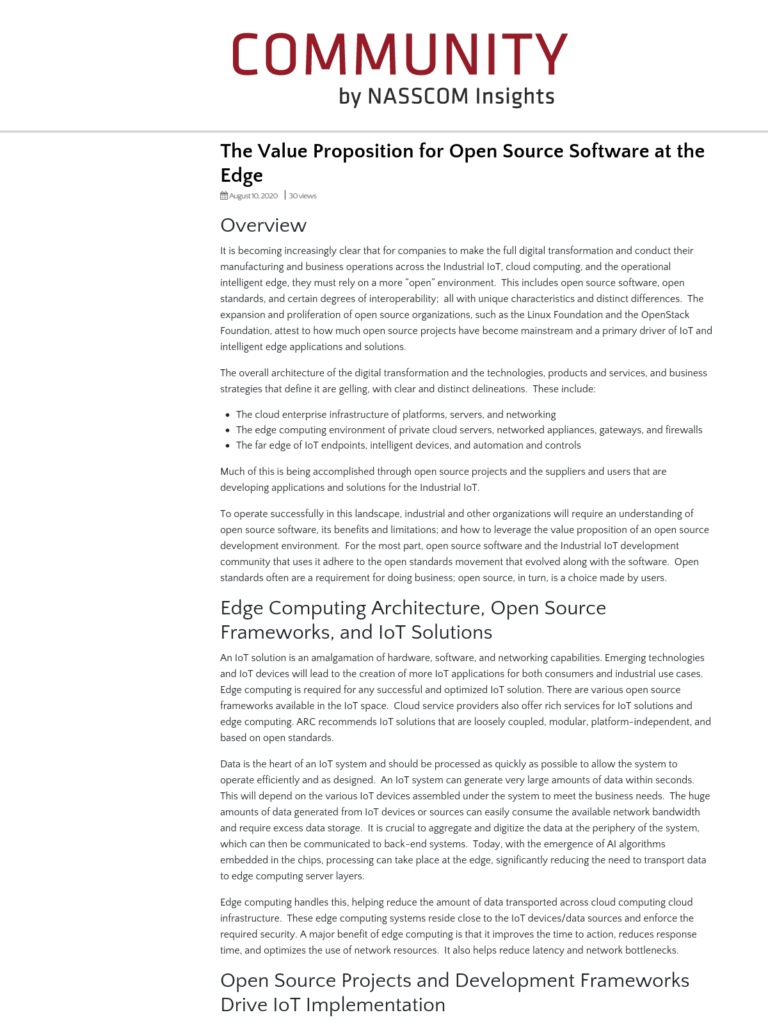The Value Proposition for Open Source Software at the Edge
Blog: NASSCOM Official Blog
Overview
It is becoming increasingly clear that for companies to make the full digital transformation and conduct their manufacturing and business operations across the Industrial IoT, cloud computing, and the operational intelligent edge, they must rely on a more “open” environment. This includes open source software, open standards, and certain degrees of interoperability; all with unique characteristics and distinct differences. The expansion and proliferation of open source organizations, such as the Linux Foundation and the OpenStack Foundation, attest to how much open source projects have become mainstream and a primary driver of IoT and intelligent edge applications and solutions.
The overall architecture of the digital transformation and the technologies, products and services, and business strategies that define it are gelling, with clear and distinct delineations. These include:
- The cloud enterprise infrastructure of platforms, servers, and networking
- The edge computing environment of private cloud servers, networked appliances, gateways, and firewalls
- The far edge of IoT endpoints, intelligent devices, and automation and controls
Much of this is being accomplished through open source projects and the suppliers and users that are developing applications and solutions for the Industrial IoT.
To operate successfully in this landscape, industrial and other organizations will require an understanding of open source software, its benefits and limitations; and how to leverage the value proposition of an open source development environment. For the most part, open source software and the Industrial IoT development community that uses it adhere to the open standards movement that evolved along with the software. Open standards often are a requirement for doing business; open source, in turn, is a choice made by users.
Edge Computing Architecture, Open Source Frameworks, and IoT Solutions
An IoT solution is an amalgamation of hardware, software, and networking capabilities. Emerging technologies and IoT devices will lead to the creation of more IoT applications for both consumers and industrial use cases. Edge computing is required for any successful and optimized IoT solution. There are various open source frameworks available in the IoT space. Cloud service providers also offer rich services for IoT solutions and edge computing. ARC recommends IoT solutions that are loosely coupled, modular, platform-independent, and based on open standards.
Data is the heart of an IoT system and should be processed as quickly as possible to allow the system to operate efficiently and as designed. An IoT system can generate very large amounts of data within seconds. This will depend on the various IoT devices assembled under the system to meet the business needs. The huge amounts of data generated from IoT devices or sources can easily consume the available network bandwidth and require excess data storage. It is crucial to aggregate and digitize the data at the periphery of the system, which can then be communicated to back-end systems. Today, with the emergence of AI algorithms embedded in the chips, processing can take place at the edge, significantly reducing the need to transport data to edge computing server layers.
Edge computing handles this, helping reduce the amount of data transported across cloud computing cloud infrastructure. These edge computing systems reside close to the IoT devices/data sources and enforce the required security. A major benefit of edge computing is that it improves the time to action, reduces response time, and optimizes the use of network resources. It also helps reduce latency and network bottlenecks.
Open Source Projects and Development Frameworks Drive IoT Implementation
Unlike proprietary software, open source technologies are completely customizable and scalable – as the code is open it can be adjusted and modified to the business’s needs. Assuming the necessary toolkit is provided, OSS allows developers and enterprises to move between different frameworks without complications.
With a great number of automated protocols and functions, open source frameworks can save time for IoT engineers and tech-professionals. While data privacy and security are one of the primary concerns of any business, companies need to be aware of some remaining challenges when using OSS. These include:
- Open means free access, i.e. contributors are not always specialists
- Secure maintenance is always vulnerable
- Data privacy can involve legal issues
- Some of the better open source development platforms can be expensive
- The set of available standard features don’t always fit all your business needs
- Open source IoT platforms are not for the casual developer
About the Author:
Dick’s focus areas include product lifecycle management (PLM), engineering design tools for plant design and infrastructure, asset lifecycle management, Industrial IoT, predictive/prescriptive analytics for production systems, digital twin, virtual simulation for product development and production systems
The post The Value Proposition for Open Source Software at the Edge appeared first on NASSCOM Community |The Official Community of Indian IT Industry.
Leave a Comment
You must be logged in to post a comment.








